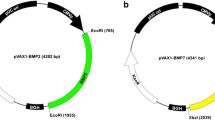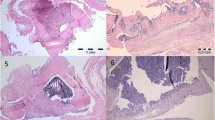Abstract
Introduction
The aim of our study was to investigate in vitro and in a new in vivo rat model for impaired bone healing whether a low dose BMP-2 preparation in fibrin would be equivalent or better than the combination of collagen and a high dose of BMP-2 which is currently in clinical use.
Materials and methods
In a 14 day period we compared the in vitro release kinetics of an absorbable collagen sponge (ACS) with 72 μg rhBMP-2 in the BMPC group and fibrin matrix with 10 μg rhBMP-2 in the BMPF group. In our in vivo experiment a critical sized osteotomy was performed in the rat femur, which was filled with a spacer, inhibiting bone formation for a period of 4 weeks. In a second operation this spacer was removed and the test item was applied into the defect. We compared the BMPF and BMPC groups with the ACS alone, FIBRIN alone and the EMPTY (4w/8w) control groups. 4 and 8 weeks after the second operation, specimens were analysed by X-ray and μCT imaging. Mechanically stable femurs were biomechanically evaluated.
Results
Cumulative BMP-2 release was five times higher in the BMPF group than in the BMPC group during the observation period. μCT analysis revealed that both the extent of bone union and the bone volume were significantly higher in the group with a lower dose of BMP-2 in fibrin matrix than in the groups without BMP-2 treatment. However there was no statistically significant difference between the BMPF and BMPC groups.
Conclusion
We conclude that fibrin matrix is an excellent carrier for BMP-2 and that it provides equivalent results with a sevenfold lower dose of BMP-2 compared with ACS.






Similar content being viewed by others
References
Lane JM (2005) Bone morphogenic protein science and studies. J Orthop Trauma 19:S17–S22
Yamamoto M, Takahashi Y, Tabata Y (2003) Controlled release by biodegradable hydrogels enhances the ectopic bone formation of bone morphogenetic protein. Biomaterials 24:4375–4383
Schmoekel HG, Weber FE, Schense JC, Gratz KW, Schawalder P, Hubbell JA (2005) Bone repair with a form of BMP-2 engineered for incorporation into fibrin cell ingrowth matrices. Biotechnol Bioeng 89:253–262
Zabka AG, Pluhar GE, Edwards RB III, Manley PA, Hayashi K, Heiner JP et al (2001) Histomorphometric description of allograft bone remodeling and union in a canine segmental femoral defect model: a comparison of rhBMP-2, cancellous bone graft, and absorbable collagen sponge. J Orthop Res 19:318–327
Kawamura M, Urist MR (1988) Human fibrin is a physiologic delivery system for bone morphogenetic protein. Clin Orthop Relat Res 302–310
Vogelin E, Jones NF, Huang JI, Brekke JH, Lieberman JR (2005) Healing of a critical-sized defect in the rat femur with use of a vascularized periosteal flap, a biodegradable matrix, and bone morphogenetic protein. J Bone Joint Surg Am 87:1323–1331
Isobe M, Yamazaki Y, Mori M, Amagasa T (1999) Bone regeneration produced in rat femur defects by polymer capsules containing recombinant human bone morphogenetic protein-2. J Oral Maxillofac Surg 57:695–698
Lee SC, Shea M, Battle MA, Kozitza K, Ron E, Turek T et al (1994) Healing of large segmental defects in rat femurs is aided by RhBMP-2 in PLGA matrix. J Biomed Mater Res 28:1149–1156
Seeherman HJ, Azari K, Bidic S, Rogers L, Li XJ, Hollinger JO et al (2006) rhBMP-2 delivered in a calcium phosphate cement accelerates bridging of critical-sized defects in rabbit radii. J Bone Joint Surg Am 88:1553–1565
Pluhar GE, Manley PA, Heiner JP, Vanderby R Jr, Seeherman HJ, Markel MD (2001) The effect of recombinant human bone morphogenetic protein-2 on femoral reconstruction with an intercalary allograft in a dog model. J Orthop Res 19:308–317
Sciadini MF, Johnson KD (2000) Evaluation of recombinant human bone morphogenetic protein-2 as a bone-graft substitute in a canine segmental defect model. J Orthop Res 18:289–302
Seeherman HJ, Bouxsein M, Kim H, Li R, Li XJ, Aiolova M et al (2004) Recombinant human bone morphogenetic protein-2 delivered in an injectable calcium phosphate paste accelerates osteotomy-site healing in a nonhuman primate model. J Bone Joint Surg Am 86-A(9):1961–1972
Schmidmaier G, Schwabe P, Wildemann B, Haas NP (2007) Use of bone morphogenetic proteins for treatment of non-unions and future perspectives. Injury 38(Suppl 4):S35–S41
Hsu HP, Zanella JM, Peckham SM, Spector M (2006) Comparing ectopic bone growth induced by rhBMP-2 on an absorbable collagen sponge in rat and rabbit models. J Orthop Res 24:1660–1669
Jones AL (2005) Recombinant human bone morphogenic protein-2 in fracture care. J Orthop Trauma 19:S23–S25
Jones AL, Bucholz RW, Bosse MJ, Mirza SK, Lyon TR, Webb LX et al (2006) Recombinant human BMP-2 and allograft compared with autogenous bone graft for reconstruction of diaphyseal tibial fractures with cortical defects. A randomized, controlled trial. J Bone Joint Surg Am 88:1431–1441
Kuklo TR, Groth AT, Anderson RC, Frisch HM, Islinger RB (2008) Recombinant human bone morphogenetic protein-2 for grade III open segmental tibial fractures from combat injuries in Iraq. J Bone Joint Surg Br 90:1068–1072
Han D, Liu W, Ao Q, Wang G (2008) Optimal delivery systems for bone morphogenetic proteins in orthopedic applications should model initial tissue repair structures by using a heparin-incorporated fibrin-fibronectin matrix. Med Hypotheses 71:374–378
Schlag G, Redl H (1988) Fibrin sealant in orthopedic surgery. Clin Orthop Relat Res 227:269–285
Schmokel HG, Weber FE, Seiler G, von Rechenberg B, Schense JC, Schawalder P et al (2004) Treatment of nonunions with nonglycosylated recombinant human bone morphogenetic protein-2 delivered from a fibrin matrix. Vet Surg 33:112–118
Schmoekel H, Schense JC, Weber FE, Gratz KW, Gnagi D, Muller R et al (2004) Bone healing in the rat and dog with nonglycosylated BMP-2 demonstrating low solubility in fibrin matrices. J Orthop Res 22:376–381
Harrison LJ, Cunningham JL, Stromberg L, Goodship AE (2003) Controlled induction of a pseudarthrosis: a study using a rodent model. J Orthop Trauma 17:11–21
Weber BG, Cech O (1976) Pseudathrosis: pathology, biomechanics, therapy, results. Hans Huber Medical Publisher, Berne
Huang Z, Nelson ER, Smith RL, Goodman SB (2007) The sequential expression profiles of growth factors from osteoprogenitors (correction of osteroprogenitors) to osteoblasts in vitro. Tissue Eng 13:2311–2320
Drosse I, Volkmer E, Seitz S, Seitz H, Penzkofer R, Zahn K et al (2008) Validation of a femoral critical size defect model for orthotopic evaluation of bone healing: a biomechanical, veterinary and trauma surgical perspective. Tissue Eng 14(1):79–88
Friedlaender GE, Perry CR, Cole JD, Cook SD, Cierny G, Muschler GF et al (2001) Osteogenic protein-1 (bone morphogenetic protein-7) in the treatment of tibial nonunions. J Bone Joint Surg Am 83-A(Suppl 1):S151–S158
Thomsen JS, Laib A, Koller B, Prohaska S, Mosekilde L, Gowin W (2005) Stereological measures of trabecular bone structure: comparison of 3D micro computed tomography with 2D histological sections in human proximal tibial bone biopsies. J Microsc 218(Pt 2):171–179
Schmidhammer R, Zandieh S, Mittermayr R, Pelinka LE, Leixnering M, Hopf R et al (2006) Assessment of bone union/nonunion in an experimental model using microcomputed technology. J Trauma 61:199–205
Dickson GR, Geddis C, Fazzalari N, Marsh D, Parkinson I (2008) Microcomputed tomography imaging in a rat model of delayed union/non-union fracture. J Orthop Res 26:729–736
Author information
Authors and Affiliations
Corresponding author
Rights and permissions
About this article
Cite this article
Schützenberger, S., Schultz, A., Hausner, T. et al. The optimal carrier for BMP-2: a comparison of collagen versus fibrin matrix. Arch Orthop Trauma Surg 132, 1363–1370 (2012). https://doi.org/10.1007/s00402-012-1551-2
Received:
Published:
Issue Date:
DOI: https://doi.org/10.1007/s00402-012-1551-2




